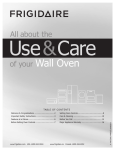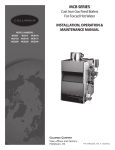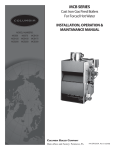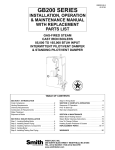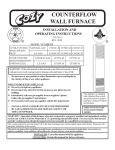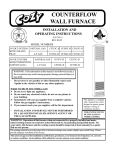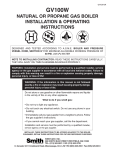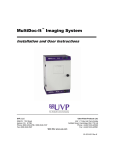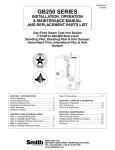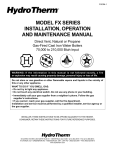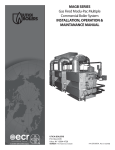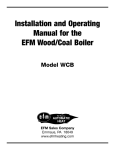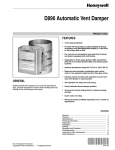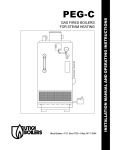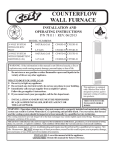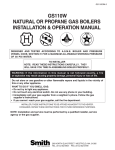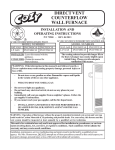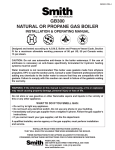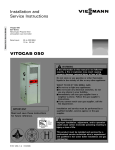Download Operation Manual
Transcript
EW2-1203 42-9510 MODEL EW SERIES INSTALLATION, OPERATION & MAINTENANCE MANUAL Gas-Fired Water Cast Iron Boilers 65,000 to 165,000 Btuh Input WARNING: If the information in this manual is not followed exactly, a fire or explosion may result causing property damage, personal injury or loss of life. Do not store or use gasoline or other flammable vapors and liquids in the vicinity of this or any other appliance. WHAT TO DO IF YOU SMELL GAS: • Do not try to light any appliance. • Do not touch any electrical switch. Do not use any phone in your building. • Immediately call your gas supplier from a neighbor’s phone. Follow the gas supplier’s instructions. • If you cannot reach your gas supplier, call the fire department. Installation and service must be performed by a qualified installer, service agency or the gas supplier. BOILER INSTALLATION Introduction.............................................. 2 Step 1: Locating & Setting Boiler............. 4 Step 2: Installing/Purging Water Piping... 5 Step 3: Venting Boiler............................... 8 Step 4: Installing/Testing Gas Piping........ 10 Step 5: Wiring Boiler................................ 12 START-UP & OPERATION Safety Controls........................................ 15 Start-Up & Adjustments........................... 15 MAINTENANCE Water Treatment ...................................... Freeze Protection..................................... Before Each Heating Season .................. How To Change Orifices........................... Troubleshooting ....................................... 18 18 18 19 19 Appendix A (French Vent Damper Translation)........... 20 WARNING: Installation and service must be performed by a qualified installer, service agency or the gas supplier in accordance with all local and national codes. Failure to comply with this warning can result in a fire or explosion causing property damage, personal injury or loss of life! IN UNITED STATES: 260 NORTH ELM ST. • WESTFIELD, MA 01085 • (413) 564-5515 • FAX (413) 568-9613 IN CANADA: 5211 CREEKBANK RD. • MISSISSAUGA, ONT. L4W 1R3 • (905) 625-2991 • FAX (905) 625-6610 AVERTISSMENT. Assurez-vous de bien suivre les instructions données dans cette notice pour réduire au minimum le risque d’incendie ou d’explosion ou pour éviter tout dommoge matériel, toute blessure ou la mort Ne pas entreposer ni utiliser d’essence ou ni d’autres vapeurs ou liquides inflammables à proximité de cet appareil ou de tout autre appareil. QUE FAIRE SI VOUS SENTEZ UNE ODEUR DE GAZ: • Ne pas tenter d’allumer d’appareil. • Ne touchez à aucun interrupteur; ne pas vous servir des téléphones se trouvant dans le bâtiment. • Appelez immédiatement votre fournisseur de gas depuis un voisin. Suivez les intructions du fournisseur. • Si vous ne purvez rejoindre le fournisseur, appelez le service des incendies. L’installation et l’entretien doivent être assurés par un installateur ou un service d’entretien qualifié ou par le fournisseur de gaz. The following terms are used throughout this manual to bring attention to the presence of potential hazards or to important information concerning the product: DANGER: Indicates an imminently hazardous situation which, if not avoided, will result in death, serious injury or substantial property damage. CAUTION: Indicates a imminently hazardous situation which, if not avoided, may result in minor injury or property damage. WARNING: Indicates a imminently hazardous situation which, if not avoided, could result in death, serious injury or substantial property damage. NOTE: Used to notify of special instructions on installation, operation or maintenance which are important to equipment but not related to personal injury hazards. 2 ANSI/ASME CODE COMPLIANCE: Installation must conform to requirements of authority having jurisdiction or, in absence of such requirements, to National Fuel Gas Code ANSI Z223.1-latest edition and to National Electric Code NFPA-70-latest edition. Where required by authority having jurisdiction, installation must also conform to Standard for Controls and Safety Devices for Automatically Fired Boilers, ANSI/ASME CSD-1. WARNING: Installers must follow local regulations with respect to the installation of CO detectors and follow the manufacturer's stated maintenance schedule for this boiler! ATTENTION: Observer les règlements règional à l'egard des détecteurs de monoxyde de carbone et observer entretien de manufacturier pour cette chaudière! For Canada, the installation must be in accordance with Standards CAN/CGA-B149 (.1 or .2) Installation Codes for Gas Burning Appliances and Equipment and with Standard C.S.A. C22.1 Canadian Electrical Code, Part 1 and Part 2, and/or local codes. BOILER SHIPMENT: Each boiler is shipped in a single carton. There is a vent damper packed separately with the boiler. In the Commonwealthof Massachusetts, the installation must be performed by a licensed plumber or gas fitter. . BOILER MODEL E F EW-65 EW-85 EW-100 EW-125 EW-145 EW-165 DIMENSIONS B D C 13-1/8" 14-1/4" 45-1/16" 13-1/8" 14-3/4" 48-5/16" 13-1/8" 14-3/4" 48-5/16" 19" 53" 13-1/8" 31" 68-1/2" 13-1/8" 13-1/8" 30-1/16" 68-1/8" A 24-3/4" 27-1/2" 27-1/2" 27-1/2" 31" 31" E 5" 5" 5" 6" 6" 7" F 6-1/16" 6-1/16" 6-1/16" 6-1/2" 6-1/2" 7-1/16" PRESS./RELIEF VALVE EW-85, 100, 125 VENT DAMPER 1-1/4" RETURN C AIR ELIMINATION TAPPING SPILL SWITCH D HI-LIMIT AQUASTAT CIRCULATOR (PACKAGED BOILERS) EXPANSION TANK TAPPING 1-1/2" SUPPLY EW-65, 145, 165 1-1/2" SUPPLY EW-85, 100, 125 PRESS./RELEF VALVE EW-65, 145, 165 A TEMP./PRESS. INDICATOR DRAIN VALVE ROLLOUT SWITCH 32-1/2" B MODEL EW BOILER DIMENSIONS 3 BOILER INSTALLATION STEP 1: LOCATING & SETTING THE BOILER ➤ PROCEDURE A: Check that provisions for combustion air are in accordance with National Fuel Gas Code ANSI Z223.1-latest edition and all applicable local codes. In Canada, follow CAN/CGA B149(0.1 or .2) installation codes. If boiler is installed in a confined space, a space with a volume of less than 50 cubic feet per 1000 Btu/hr of gas input for all fuel burning equipment, or building construction is unusually tight, adequate air for combustion must be provided by two openings: one located about 6" below the ceiling, the other about 6" above the floor. When communicating directly with the outside, each opening must have a minimum free area of one square inch per 4000 Btu/hr of gas input. When ventilation air is provided by openings in doors, etc. to adjoining spaces having adequate infiltration, each opening must have a minimum free area of one square inch per 1000 Btu/hr of gas input. WARNING: This boiler must be supplied with combustion air in accordance with Section 5.3, Air for Combustion & Ventilation, of the latest edition of the National Fuel Gas Code, ANSI Z223.1 and all applicable local building codes. Failure to provide adequate combustion air for this appliance can result in excessive levels of carbon monoxide which can result in severe personal injury or death! If boiler is installed in an unconfined space, adequate air will be available via normal infiltration. NOTE: Boiler employs atmospheric combustion. Combustion air must not be contaminated with halogenated hydrocarbon vapors, aerosol propellants or freon; otherwise, heat exchanger will be subject to corrosion, reducing boiler life. ➤ PROCEDURE B: Check minimum clearances to combustibles are proper as shown. Local requirements may specify greater clearances & must be adhered to. Boiler shall be installed such that the gas ignition system components are protected from water, dripping, spraying, rain, etc., during appliance operation and service, circulator replacement, condensate trap, control replacement, etc. 6" 6" VENT DAMPER LEFT 6" RIGHT 6" FRONT VIEW TOP 48" FRONT CLOSET REAR 6" 6" RECOMMEND MORE FOR ACCESS TO VENT DAMPER POSITION INDICATOR SIDE VIEW FIGURE 1.1 WARNING: Never install boiler on combustible flooring without combustible flooring pan or on carpeting as heat damage and/or fire may result. CAUTION: Locate boiler so horizontal connecting flue pipe is as short as possible. Maximize height of vertical flue connector. CAUTION: Do not loosen tie rods on absorption unit. They accommodate thermal expansion. Loss of boiler structural integrity and water leaks/damage may result. DOME ➤ PROCEDURE C: Check component positioning. BAFFLE GRID 1. Remove all packing material from boiler. 2. Check that burners and controls are in the proper position. 3. Check proper seating of baffle grid or baffle inside of dome opening (see Figure 1.2). 4 FIGURE 1.2 STEP 2: INSTALLING & PURGING WATER PIPING CAUTION: Boiler must not be used without forced circulation, as overheating or failure of cast iron sections may result. ➤ PROCEDURE A: Install vent tapping assembly, components and relief valve discharge piping. For Models EW-85, 100 & 125, supply outlet is on the top front of the boiler and vent fitting assembly tapping is at top-rear of boiler. Relief Valve Discharge Piping: Must terminate 6" above floor & be same size or larger than valve outlet, Figure 1.3. WARNING: No valve of any type may be installed between the boiler and relief valve or an explosion from over-pressure may occur. CAUTION: Piping must be installed from relief valve discharge so there will be no danger of scalding personnel. 1/2" NPT TAPPING PRESS. RELIEF VALVE RELIEF VALVE DISCHARGE PIPING AIR VENT VENT FITTING ASS'Y. HORIZONTAL EXPANSION TANK ARRANGEMENT VERTICAL EXPANSION TANK ARRANGEMENT (PREFERRED) MAY BE PIPED TO EITHER SIDE OF BOILER MAY BE SCREWED INTO TAPPING FIGURE 1.3 ➤ PROCEDURE B: Install supply and return water piping. For Models EW-85, 100 & 125, supply outlet is on top-front of boiler and vent fitting assembly tapping is at toprear of boiler, Figure 1.4. If boiler is installed above level of radiation, a low water cut-off must be used. NOTE: ALL EXTERNAL PIPING MUST BE SUPPORTED BY HANGERS, NOT BY BOILER OR ACCESSORIES. CAUTION: To prevent damage due to excessive condensation, one of the following piping options should be used, see next page. FIGURE 1.4 5 PUMPED BLEND An additional circulator can also be used to provide a return water temperature blend. This method works well with systems with multiple zones with circulators (see Fig. 1.7). The dedicated bypass circulator provides a strong blending flow without diminishing the flow available to any heating zone. Any residentially sized circulator is adequate for this purpose. SYSTEM BYPASS For systems using a circulator on the return as either a single zone, or multiple zones with zone valves, install a system bypass line between the supply and return on the suction side of the circulator (see Fig 1.5). Install a metering valve in this bypass line to regulate the amount of flow that will be diverted to the return. A plug valve offers the best control for this application. Although other valves may be less expensive, a plug valve will be easier to set accurately. Each of these bypass solutions also has the added benefit of increasing circulation in the boiler which will maximize tankless coil output and increase the accuracy of temperature sensing controls. In the absence of a flow indicator, set the metering valve using temperature as a guide. The accompanying diagram suggests one scenario. This addition requires only two tees, a plug valve, and a small amount of pipe and offers the simplest approach to reliably controling condensation. For this system and those that follow, be aware that you are using a percentage of the pump capacity to blend, but the friction loss for the entire pump flow has been reduced. In most cases, the standard pump packaged with the boiler has enough capacity to feed the baseboard distribution system and the bypass line. SUPPLY RETURN 100% 120° F 100% 160° F 100% 160° F 200% 140° F 200% 160° F PUMPED BYPASS SUPPLY REVERSE ACTING AQUASTATS An alternative for existing systems experiencing condensation that does not require re-piping the boiler utilizes a reverse acting aquastat, one that makes on temperature rise. This approach works best in single zone systems. Wired in series with the circulator, this control holds the circulator off until the boiler reaches an acceptable temperature and then starts system circulation (see Fig. 1.8). 50% 120° F 50% 160° F 50% 160° F 100% 160° F FIGURE 1.7 RETURN 100% 140° F SYSTEM BYPASS FIGURE 1.5 The most commonly available reverse acting aquastat is a Honeywell L4006B. The aquastat should be mounted in an immersion well directly installed in the boiler. The use of heat conductive grease (Honeywell par t # 972545) in the immersion well is strongly recommended for fast and accurate temperature response. Set this adjustable aquastat to make at no less than 130° F. While this method can cause the circulator to cycle more frequently, setting the aquastat’s differential to the maximum (25-30°F) will minimize short cycling. PUMP AWAY BYPASS For systems that use a single circulator to pump away from the boiler, the bypass should be installed on the discharge side of the circulator (see Fig. 1.6). Full temperature water supplies the baseboard distribution system as before. Half of the circulator’s volume moves through the bypass, blending and heating the cooler return water. Again, the cost of installing the bypass is small and setting it by temperature can be accomplished with a contact thermometer. 115 volts SUPPLY reverse aquastat RETURN N.O. 50% 120° F 50% 160° F circulator 50% 160° F 100% 160° F 100% 140° F 24 volts T t'stat T PUMP AWAY BYPASS FIGURE 1.6 REVERSE AQUASTAT operating aquastat SET AT 120° F N.C. GV FIGURE 1.8 6 ➤ PROCEDURE C: For combination heating and cooling installations only. NOTE: VALVES "H" OPENED ON HEATING WITH "C" VALVES CLOSED REVERSE PROCEDURE ON COOLING. If a hot water boiler is installed in connection with a water chiller, the chilled water must be piped in parallel with the boiler, using appropriate valves to prevent the chilled medium from entering the boiler, Figure 1.9. When boilers are connected to heating coils located in air handling units where they may be exposed to refrigerated air circulation, the boiler piping system shall be equipped with flow-control valves or other automatic means to prevent gravity circulation of the boiler water during the cooling cycle. EXP. TANK VENT ROOM UNIT H RELIEF VALVE C PUMP DRAIN BOILER FILL VALVE H C DRAIN BOILER CHILLER FIGURE 1.9 ➤ PROCEDURE D: Completely fill & purge heating system. Make sure that all heating system manual air vents are closed. 1. Check that flow direction arrows on hydronic components are facing in proper direction. 2. Attach hose to drain valve “B”, Figure 1.10, and close valve “A”. Open valves “C”, “D”, “E” and “F” and drain valve “B”. Fill system with water until water runs out of the hose in a steady stream, no visible air bubbles. 3. Close valves “C” and “D”. Open valve “A”. When water runs out of the hose in a steady stream, no visible air bubbles, close drain valve “B”. FIGURE 1.10 FOR WATER TREATMENT & FREEZE PROTECTION REQUIREMENTS, SEE “ MAINTENANCE” IN THIS MANUAL 7 STEP 3: VENTING THE BOILER DANGER: Draft hood and vent outlet must not be altered, as proper operation would be jeopardized; flame rollout, fire or carbon monoxide poisoning will result. NOTE: Additional venting and chimney requirements are provided on page 8. ➤ PROCEDURE A: Mount draft hood and spill switch on boiler. INSTALL SWITCH IN OPENING ON DRAFTHOOD 1. Install draft hood on boiler. If draft hood shroud has a hole near the relief opening, mount draft hood so hole faces to the front of the boiler. CONNECT WIRE LEADS INSTALL MOUNTING BRACKET ON DRAFTHOOD 2. EW boilers are equipped with factory-mounted spill switch harness/mounting bracket assembly; spill switch is provided in bag on boiler front. 3. Install mounting bracket on outside surface of draft hood shroud with the screws provided (HARNESS MUST BE ON OUTSIDE OF SHROUD). Install spill switch in hole in shroud (on outside surface) with the screws provided, Figure 1.11. FIGURE 1.11 4. Plug wiring leads from harness/bracket assembly onto flat terminals on spill switch. NOTE: Boiler will not operate unless wiring leads to spill switch are connected. ➤ PROCEDURE B: Install vent damper. (For French version, see Appendix A at rear of manual.) DANGER: Only the boiler may be served by the vent damper. Do not use it to vent an additional appliance; this will cause fire or carbon monoxide poisoning. 1. Mount damper on top of draft hood. FLOW DIRECTION ARROW POINTS UP 3. Connect wire harness. MAKE SURE MOTOR IS LOCATED ON LEFT SIDE PLUG INTO MOLEX RECEPTACLE INSIDE DAMPER MOTOR MOUNT VENT DAMPER OVER DRAFTHOOD FIGURE 1.12 VENT DAMPER WIRE HARNESS 2. Secure damper to draft hood. ATTACH LOWER PORTION OF VENT DAMPER TO DRAFTHOOD WITH 1/2" OR SHORTER SCREWS OR POP RIVETS FIGURE 1.14 FIGURE 1.13 8 PLUG INTO MOLEX RECEPTACLE ON FRONT OF BOILER ➤ PROCEDURE C: Install flue pipe between vent damper and chimney. A 6" minimum clearance is required between flue pipe and all combustible construction. USE VENT SUPPORT(S) AS REQUIRED TO PREVENT SAGGING SINGLE WALL OR TYPE B FLUE PIPE EW-65 = 5" EW-85 = 5" EW-100 = 5" EW-125 = 6" EW-145 = 6" EW-165 = 7" MAXIMUM 6-FT APART PITCH 1/4" PER FOOT SECURE FLUE PIPE TO VENT DAMPER INSTALL FLUSH WITH INSIDE CHIMNEY LINER SEAL WITH FURNACE CEMENT 1. Seal all unused openings in common venting system. 2. Visually inspect the venting system for proper size and horizontal pitch and determine there is no blockage or restriction, leakage, corrosion and other deficiencies which could cause an unsafe condition. 3. Insofar as is practical, close all building doors and windows and all doors between the space in which the appliances remaining connected to the common venting system are located and other spaces of the building. Turn on clothes dryers and any appliance not connected to the common venting system. Turn on any exhaust fans, such as range hoods and bathroom exhausts, so they will operate at maximum speed. Do not operate a summer exhaust fan. Close fireplace dampers. 4. Place in operation the appliance being inspected. Follow the lighting instructions. Adjust thermostat so appliance will operate continuously. 5. Test for spillage at draft hood relief opening after 5 minutes of main burner operation. Use the flame of a match or candle, or smoke from cigarette, cigar or pipe. 6. After it has been determined that each appliance remaining connected to common venting system properly vents when tested as outlined above, retur n doors, windows, exhaust fans, fireplace dampers and any other gas-burning appliance to previous conditions of use. 7. Any improper operation of the common venting system should be corrected so installation conforms with the National Fuel Gas Code, ANSI Z223.1-latest edition. When resizing any portion of the common venting system, the common venting system should be resized to approach the minimum size as determined using the appropriate tables in Appendix G in the National Fuel Gas Code, ANSI Z223.1-latest edition. For Canada, the provisions of CAN/CGA B149.1 or .2 shall apply. FIGURE 1.15 ADDITIONAL VENTING REQUIREMENTS: When connecting to gas vents or chimneys, vent installations shall be in accordance with Part 7, Venting of Equipment, of the National Fuel Gas Code, ANSI Z223.1-latest edition, or applicable provisions of the local building codes. ADDITIONAL CHIMNEY REQUIREMENTS: Chimney condition is of paramount importance for a safe and efficient boiler installation. All installations must include a chimney inspection by a qualified individual or agency. Chimney construction materials must be compatible with the fuel being used. Vent connectors serving appliances vented by natural draft shall not be connected into any portion of mechanical draft systems operating under positive pressure. When two or more appliances vent into a common flue, the area of the common flue should be at least equal to the area of the largest flue plus 50% of the areas of the additional flue or vent connectors. Particular attention should be paid on all oil-to-gas conversions. Soot may have accumulated in the chimney and/or degraded the chimney liner. Most utilities require complete chimney cleaning. Others may require installation of a new liner, or other chimney upgrades. Check with local utility for required safety precautions. When an existing boiler is removed from a common venting system, common venting system is likely to be too large for proper venting of appliances remaining connected to it. At time of removal of existing boiler, following steps shall be followed with each appliance remaining connected to the common venting system placed in operation, while other appliances remaining connected to common venting system are not in operation: DANGER: A chimney which does not meet modern safety standards will result in a fire or deadly carbon monoxide poisoning of the building residents. 9 STEP 4: INSTALLING & TESTING GAS PIPING ➤ PROCEDURE A: Select gas pipe size which will result in a pressure drop of less than 0.3" W.C. for natural gas or 0.5" W.C. for propane, following example below. Example: Boiler Model EW-125 is to be installed. Distance from existing gas meter to installation site is 20 ft. What pipe size must be used? Local utility indicates heating value of natural gas being supplied is 1020 Btu per cu.ft. Determine cubic feet of gas per hour for above boiler model: 125,000 Btu per hour = 122.5 cu.ft. per hour 1020 Btu per cu.ft. 1. Find 20 ft. in upper portion of the table for natural gas under “Length of Pipe, Feet” heading. 2. Moving down the column, match required capacity. Higher capacity acceptable. In our case it is 190 cu.ft. 3. Move to left-hand column “Nominal Iron Pipe Size, Inches”; read required pipe size. In our case it is 3/4 4. Take into account the effects of pipe fittings when determining the correct pipe size. Maximum Capacity of Pipe in Cubic Feet of Natural Gas per Hour for Gas Pressures of 0.5 Psig or Less and a Pressure Drop of 0.3 Inch Water Column (Based on a 0.60 Specific Gravity Gas) Nominal Iron Pipe Internal Size, Diameter, Inches Inches 1/4" 3/8" 1/2" 3/4" 1" 1-1/4" 1-1/2" 2" 2-1/2" 3" 4" .326 .493 .622 .824 1.049 1.380 1.610 2.067 2.469 3.026 4.026 Length of Pipe, Feet 10 20 30 40 50 60 32 22 72 49 132 92 278 190 520 350 1,050 730 1,600 1,100 3,050 2,100 4,800 3,300 8,500 5,900 17,500 12,000 18 40 73 152 285 590 890 1,650 2,700 4,700 9,700 15 34 63 130 245 500 760 1,450 2,300 4,100 8,300 14 30 56 115 215 440 670 1,270 2,000 3,600 7,400 12 27 50 105 195 400 600 1,150 1,850 3,250 6,800 70 80 90 100 125 150 175 200 11 11 10 9 8 8 7 6 25 23 22 21 18 17 15 14 46 43 40 38 34 31 28 26 96 90 84 79 72 64 59 55 180 170 160 150 130 120 110 100 370 350 320 305 275 250 225 210 560 530 490 460 410 380 350 320 1,500 990 930 870 780 710 650 610 1,700 1,600 1,500 1,400 1,250 1,130 1,050 980 3,000 2,800 2,600 2,500 2,200 2,000 1,850 1,700 6,200 5,800 5,400 5,100 4,500 4,100 3,800 3,500 Maximum Capacity of Pipe in Thousands of Btu per Hour of Undiluted Liquefied Petroleum gases (at 11 Inches of Water Column Inlet Pressure) (Based of a Pressure Drop of 0.5 Inch Water Column) Nominal Iron Pipe Size, Inches 1/2" 3/4" 1" 1-1/4" 1-1/2" 2" Length of Pipe, Feet 10 275 567 1071 2205 3307 6221 20 30 189 152 393 315 732 590 1496 1212 2299 1858 4331 3465 40 50 60 129 114 267 237 504 448 1039 937 1559 1417 2992 2646 103 217 409 834 1275 2394 70 80 96 89 196 185 378 346 771 724 1180 1086 2205 2047 90 100 83 78 173 162 322 307 677 630 1023 967 1921 1811 125 150 69 146 275 567 866 1606 63 132 252 511 787 1498 FIGURE 1.16 10 ➤ PROCEDURE B: Connect gas piping from meter to boiler following good piping practices. Pipe joint compound must be compatible with LP gas. Check local codes and utilities for any additional requirements. ALL PIPING MUST BE SUPPORTED BY HANGERS, NOT BY BOILER OR ACCESSORIES. FIGURE 1.17 ➤ PROCEDURE C: Test Gas Piping: DANGER: Before placing gas piping into service, carefully test it to ensure every joint is gas tight. Leak test all joints with a soap solution. NEVER TEST WITH AN OPEN FLAME AS FIRE OR EXPLOSION MAY RESULT! For any pressure testing in excess of 1/2 psi, the boiler and its individual shutoff valve must be isolated from the piping system by disconnecting them and capping the outlet(s). For any pressure testing equal to or less than 1/2 psi, the boiler must be isolated from the piping system by closing its manual shutoff valve. Minimum pressure required at the gas valve inlet is 5" W.C. for natural gas and 11" W.C. for propane. Maximum pressure allowable at the gas valve inlet is 12"W.C. If the gas pressure is above this limit, a pressure regulator must be installed. If the gas pressure is below these limits, contact the local utility. When testing has been completed, close main gas shut-off valve & set boiler combination gas valve in “off” position. STEP 5: WIRING THE BOILER NOTE: If any original wire supplied with the boiler must be replaced, use similar wire of 105 C rating. Otherwise, insulation may melt or degrade, exposing bare wire. WARNING: Turn off electric power supply before servicing. Contact with live electric components can cause shock or death. All electrical wiring must be in accordance with requirements of authority having jurisdiction or, in absence of such requirements, to National Electric Code NFPA-70latest edition. If external source is utilized, boiler must be electrically grounded in accordance with the requirements of authority having jurisdiction or, in absence of such requirements, with National Electric Code NFPA70-latest edition. UL listed power limited circuit cable is almost universally approved for safety controls on heating equipment, either internally or externally, without protection of conduits or raceways. NOTE: The boiler transformer must not be used to power external accessories such as zone valves or relays. Otherwise, boiler transformer will be overloaded and will burn out. A separate 115V, 60Hz power supply is recommended for the boiler. Use standard 15-amp fuse and 14-gauge wire from power supply to boiler. Follow the wiring diagram for your particular installation as shown in Figures 1.18 through 1.28. For Canada, all electrical connections are to be made in accordance with Standard C.S.A. C22.1 Canadian Electrical Code, Part 1 and Part 2 and/or local codes. 11 OPERATING SEQUENCE FOR BOILERS EQUIPPED WITH STANDING PILOT VENT DAMPER AND HI-LIMIT OPERATING SEQUENCE FOR BOILERS EQUIPPED WITH VENT DAMPER STANDING PILOT AND L48148E MOTOR DRIVES VENT DAMPER TO CLOSED POSITION AND MOTOR DRIVES VENT DAMPER TO CLOSED POSITION AND REMAINS CLOSED DURING STANDBY. REMAINS CLOSED DURING STANDBY. STANDING PILOT REMAINS LIT. SENSING CIRCUIT IS CONTINUOUSLY MONITORED. THERMOSTAT (OR OPERATING CONTROL) CALLS FOR HEAT. DAMPER BLADE OPENS. DAMPER END SWITCH CLOSES (PROVING VENT DAMPER OPEN). IF NO FAILURE EXISTS, THE MAIN VALVE IS ENERGIZED. STANDING PILOT REMAINS LIT. SENSING CIRCUIT IS CONTINUOUSLY MONITORED. THERMOSTAT (OR OPERATING CONTROL) CALLS FOR HEAT. DAMPER BLADE OPENS. DAMPER END SWITCH CLOSES (PROVING VENT DAMPER OPEN). MAIN VALVE IS ENERGIZED. UNIT OPERATES UNTIL THERMOSTAT (OR OPERATING CONTROL) UNIT OPERATES UNTIL THERMOSTAT (OR OPERATING CONTROL) IS SATISFIED. IS SATISFIED. SYSTEM RETURNS TO STANDBY WITH DAMPER CLOSED. SYSTEM RETURNS TO STANDBY WITH DAMPER CLOSED. FACTORY WIRED FIELD WIRED THERMOSTAT OR OPER. CONTROL T1 TT FACTORY WIRED FIELD WIRED T1 TT TT HI-LIMIT BLUE BLUE 1 VENT DAMPER 2 3 4 WHT T2 L1 BLK L2 Z B1 B2 CIRC. C1 C2 L1 L2 T2 L1 115V 60HZ BLUE GND WHT W TV T THERMOSTAT OR OPER. CONTROL 115/24V TRANSF. BLK L8148E TT SPILL SWITCH RED 115V 60 HZ L2 GND SPILL SWITCH BLUE BLUE ROLLOUT SWITCH TH VENT DAMPER TR BLK 1 2 ROLLOUT SWITCH WHT GAS VALVE RED 3 TH BLUE 4 24V GAS VALVE TR IF ANY OF THE ORIGINAL WIRE AS SUPPLIED WITH THE BOILER MUST BE REPLACED, USE A SIMILIAR WIRE OF 105˚ C RATING. IF ANY OF THE ORIGINAL WIRE AS SUPPLIED WITH THE BOILER MUST BE REPLACED, USE A SIMILIAR WIRE OF 105˚ C RATING. T2 L1 L2 T2 L1 115V 60HZ L1 N C1 SPILL SWITCH B THERMOSTAT OR OPER. CONTROL T1 TT C2 1K2 R B1 HI-LIMIT SPILL SWITCH TT 1 2 3 4 B2 1 2 3 4 VENT DAMPER VENT DAMPER TH TH ROLLOUT SWITCH TR ROLLOUT SWITCH W 1K TV T1 TT T TT SPILL AND ROLLOUT SWITCHES USED WHEN INPUT IS LESS THAN 300,000 BTUH 42-5768 FIGURE 1.18: WIRING DIAGRAM & OPERATION SEQUENCE FOR BOILERS WITH STANDING PILOT & VENT DAMPER TR 1 GAS VALVE GAS VALVE Z SPILL AND ROLLOUT SWITCHES USED WHEN INPUT IS LESS THAN 300,000 BTUH 115V 60 HZ GND 115/24V 115/24V HI-LIMIT L2 CIRC. MOTOR 1K1 115V AC H L2 115 V AC GND THERMOSTAT OR OPER. CONTROL 42-5769 FIGURE 1.19: WIRING DIAGRAM & OPERATION SEQUENCE FOR BOILERS WITH STANDING PILOT, VENT DAMPER & L8148E AQUASTAT RELAY 12 OPERATING SEQUENCE FOR BOILERS EQUIPPED WITH VENT DAMPER ELECTRONIC PILOT CONTROL AND L48148E MOTOR DRIVES VENT DAMPER TO CLOSED POSITION AND REMAINS CLOSED DURING STANDBY. SENSING CIRCUIT IS CONTINUOUSLY MONITORED. THERMOSTAT CALLS FOR HEAT. DAMPER BLADE OPENS. DAMPER END SWITCH CLOSES (PROVING DAMPER OPEN). IF NO FAILURE EXISTS, THE PILOT VALVE AND IGNITOR ARE ENERGIZED. PILOT IS IGNITED AND SENSOR SENSES FLAME. MAIN VALVE IS ENERGIZED AND IGNITOR DE-ENERGIZED. UNIT OPERATES UNTIL THERMOSTAT IS SATISFIED. SYSTEM RETURNS TO STANDBY WITH DAMPER CLOSED. FACTORY WIRED FIELD WIRED T1 TT THERMOSTAT OR OPER. CONTROL TT AQUA. RELAY L8148E Z TV T C1 C2 B1 B2 CIRCULATOR L1 L2 T2 L1 L2 BLUE SPILL SWITCH 115V 60HZ GND GAS VALVE S8600 (TH-TR) (TR) VENT DAMPER 1 WHT 2 BLUE BLK PV BRN PURP MV/PV MV (TH) GND BLK RED 3 4 MV MV/PV PV 24(GND) 24V ROLLOUT SWITCH IGNITOR SENSOR SPARK IF ANY OF THE ORIGINAL WIRE AS SUPPLIED WITH THE BOILER MUST BE REPLACED, USE A SIMILIAR WIRE OF 105˚ C RATING. T2 L1 L2 115 V AC L1 L2 CIRC. MOTOR 1K1 115V 60HZ GND C2 C1 115/24V B 1K2 HI-LIMIT VENT DAMPER 1 2 3 4 R B1 MANUAL RESET SPILL SWITCH MV (TH) (TR) PURP PV 1K MV MV/PV PV GND GAS VALVE 24(GND) 24V IGNITOR SENSOR W BLK BRN MV/PV (TH-TR) ROLLOUT SWITCH Z B2 S8600 TV T1 L1 T L2 SPILL AND ROLLOUT SWITCHES USED WHEN INPUT IS LESS THAN 300,000 BTUH SPARK THERMOSTAT OR OPER. CONTROL 42-5767 FIGURE 1.23: WIRING DIAGRAM & OPERATION SEQUENCE FOR BOILERS WITH IID, VENT DAMPER FIGURE 1.22: WIRING DIAGRAM & OPERATION SEQUENCE FOR BOILERS WITH IID, VENT DAMPER & L8148E AQUASTAT RELAY 13 N 115V H T2 ZV1 TH1 YEL RED YEL RED W ZV2 TH2 TV YEL RED YEL RED T 2 R1 TO CIRC. ZV3 TH3 B1 B2 C1 C2 L1 L2 N 115V RED YEL H YEL T2: 24V TRANSF. TH1: ZONE T'STAT TH2: ZONE T'STAT TH3: ZONE T'STAT RED ZV1: ZONE VALVE ZV2: ZONE VALVE ZV3: ZONE VALVE TH GV R1: AQUASTAT RELAY - L8148E GV: GAS VALVE TR FIGURE 1.20: WIRING DIAGRAM FOR ZONING WITH ZONE VALVES FACTORY WIRING GAS VALVE COIL T1 FIELD WIRING 115V TO ADDITIONAL ZONES 2R-2 1R-2 TH1 H1 TH2 BOILER CIRCUIT BLACK X X T T T T ZR2 ZR1 2 1 3 4 X X 1R-1 2 1 3 4 2R-1 T2 TH1 T3 TH2 H1 115V ZR1 H 115V CIRC. 2 CIRC. 1 N ZR2 T1 C2 C1 GV TH TR WHITE EXTERNAL CIRCUIT C1: ZONE CIRCULATOR C2: ZONE CIRCULATOR TH1: ZONE T'STAT TH2: ZONE T'STAT ZR1: ZONE RELAY (RA832A OR EQUIVALENT) ZR2: ZONE RELAY (RA832A OR EQUIVALENT) H1: HI-LIMIT AQUASTAT GV: GAS VALVE T1: 24V TRANSFORMER T2,T3: TRANSF. (IN RELAYS) 1R-1, 1R-2: ZR1 CONTACTS 2R-1, 2R-2: ZR2 CONTACTS FIGURE 1.21: WIRING DIAGRAM FOR ZONING WITH CIRCULATORS 14 START-UP & OPERATION SAFETY CONTROLS The spill switch, see Figure 2.1, detects the escape of combustion products through the draft hood relief opening and interrupts the power to the gas valve FIGURE 2.1 preventing unsafe boiler operation. Escape of flue products could be caused by a blocked or collapsed chimney or by inadeSPILL quate chimney draft. SWITCH This is a manual reset-type device and can be reactivated by ROLLOUT SWITCH depressing the spill switch reset button. 2. Make sure boiler combination gas valve is in OFF position. Then, open main gas shutoff valve, allowing gas to flow to boiler. 3. Set thermostat heat anticipator at .8 amp when therm-ostat is controlling boiler directly. When zone controlled, set heat anticipator to amp draw of zone valve(s) or circulator pump relay. 4. Set thermostat to call for heat and turn DAMPER POSITION INDICATOR MUST BE IN VISIBLE LOCATION on electrical power to FOLLOWING INSTALLATION. boiler. Observe that vent damper position indicator has rotated to open position, see Figure 2.2. Damper CLOSED OPEN must be in open position when boiler main burner is FLOW DIRECTION operating. In case of a damper FIGURE 2.2 malfunction, the damper blade may be manually placed in the full open position to permit burner operation. To accomplish this follow the instructions on the damper. The flame rollout switch, see Figure 2.1, prevents flame rollout from the boiler combustion chamber, caused by blocked boiler flue passageways, by interrupting power to the gas valve to prevent unsafe boiler operation. This is either a single use device and must be replaced if it is tripped or a manual reset-type device that can be reset by depressing the reset button. Flue passages must be inspected by a qualified installer, prior to switch replacement, if a problem occurs . 5. Allow circulator to run 15 to 30 minutes, which should purge any leftover air from system. Check automatic air vent for the proper operation and the entire system for any leaks. Make sure all air is purged from system before lighting boiler. DANGER: If flame rollout switch or spill switch trips repeatedly during start-up or operation, it indicates a hazardous condition that must be corrected immediately. WARNING: If boiler cannot be restored to normal operation after resetting of spill switch, or if flame rollout switch has tripped, do not attempt to put the boiler in operation. Immediately contact a qualified service professional. 6. Set thermostat to no longer call for heat. Observe that damper position indicator rotates to the closed position. 7. Set thermostat to lowest setting and light boiler following lighting instructions in Figure 2.4. Boiler is equipped with flame rollout switch to shut down boiler in case of sustained flame roll-out or excessive heat be-hind front panel. If switch opens, see the information on “Safety Controls” on this page. START-UP & ADJUSTMENTS Safe lighting and other performance criteria were met with the gas manifold and control assembly provided on the boiler when the boiler underwent tests specified in ANSI Z21.13-latest edition. 8. Observe pilot and main burner flame, see Figure 2.3. All burner ports should be ignited and burn with a steady blue flame. CAUTION: Never leave the job with yellow burning flames. This condition indicates poor combustion and will quickly carbonize the boiler, reducing efficiency and boiler life. It may also be an indication of improper venting or combustion air supply. If unable to adjust flame properly, consult your local utility. WARNING: Keep boiler area clear and free from combustible materials, gasoline and other flammable vapors and liquids. Otherwise, fire or explosion may result. 1. Bleed all heating system air vents, starting on lowest floor. Open vents one at a time until water squirts out. Close vent and repeat procedure with remaining vents. 15 Q345A INTERMITTENT IGNITION PILOT MODELS Q314A/Q309A CONSTANT PILOT MODELS NORMAL PILOT FLAME NORMAL LIFTING (HARD FLAME) (TOO MUCH AIR) YELLOW TIPPING (MARGINAL) MAIN BURNER FLAMES 9. Boilers are shipped from the factory with the primary air shutters on the main burner wide open. It is recommended these air shutters be left in the wide open position unless there is lifting of the flame above the burner ports. If there is lifting, the air shutters should be gradually closed until the lifting is eliminated. It may also be necessary to adjust the primary air shutters if the input rate is reduced by a change in the orifices. YELLOW FLAME (TOO LITTLE AIR) FIGURE 2.3 11. If boiler input needs to be corrected, adjust the combination gas valve pressure regulator. Regulator is factory set at 3.5" W.C. for natural gas or 10" W.C. for propane. Turn adjusting screw clockwise to increase gas flow, increase input. Turn adjusting screw counterclockwise to decrease gas flow (decrease input). In no case, should final manifold pressure setting vary more than .2" from factory-set pressures. If rated input cannot be obtained with regulator adjustment, gas supply pressure or orifice size may be the cause. Consult your local utility and Hydrotherm. 10. After burner has been in operation for about 10 minutes, check gas input rate to boiler as follows: 12. The gas burner orifices supplied with the boiler have been carefully designed to provide the correct gas input rate for most gas conditions typically found in the U.S. Occasionally, however, the local gas characteristics may not allow the unit to be properly adjusted for input. If this is the case, the local utility or Hydrotherm may recommend the orifices be changed. When changing orifices, follow the procedures in the Maintenance Section of this manual. a. Make sure that all appliances served by the gas meter are turned off during timing of gas input rate to the boiler. b. Measure the time in seconds that it takes for the boiler to use10 cubic feet of gas. Divide 36,000 by the number of seconds, this is the number of cubic feet of gas used per hour. Multiply this figure by the heating value of the gas to obtain the input in Btu per hour. 13. Start and stop burners several times by raising and lowering the thermostat setting. Example: An HC-125E boiler takes 4 minutes, 54 seconds to use 10 cubic feet of natural gas. Local utility indicated heating value of the natural gas being supplied is 1020 Btu/cu ft. Therefore: 14. After the boiler has been firing long enough to raise the boiler water temperature to above the minimum setting of the high limit, check the high limit by turning its setting from maximum to minimum setting. This should turn the boiler off. Return high limit to desired setting. 54 + (4x60) = 294 seconds 36,000 x 1020 = 124,898 Btu/hr 294 15. Check boiler safety shut-off controls. a. For boilers with standing pilot, with boiler firing, disconnect thermocouple lead from the valve. The valve should close. Therefore, the boiler input is correct. NOTE: Before calculating the input of the heating equipment, obtain the heating value of the gas from the local utility. b. For boilers with intermittent pilot, with boiler firing, disconnect wire connection to the "PV" terminal on Honeywell S8600 control. The gas valve should close. 16 WARNING If you do not follow these instructions exactly, a fire or explosion may result with property damage, personal injury, or loss of life. B. Use only your hand to turn the gas control knob. Never use tools. If the knob will not turn by hand, don't try to repair it, call a qualified service technician. Force or attempted repair may result in a fire or explosion. A. Before lighting, smell all around the appliance area for gas. Be sure to smell next to the floor because some gas is heavier than air and will settle on the floor. WHAT TO DO IF YOU SMELL GAS • Do not try to light any appliance. • Do not touch any electrical switch; do not use any phone in your building. • Immediately call your gas supplier from a neighbor's phone. Follow the gas supplier's instructions. • If you cannot reach your gas supplier, call the fire department. C. Do not use this appliance if any part has been under water. Immediately call a qualified service technician to inspect the appliance and to replace any part of the control system and any gas control which has been underwater. LIGHTING CONTINUOUS PILOT INSTRUCTIONS Honeywell VR8200 Natural or Propane Gas This appliance has a pilot which must be lit by hand. When lighting the pilot, follow these instructions exactly. 1. 2. 3. 4. 5. 6. 7. 8. 9. STOP! Read the safety information above on this page. Set the thermostat to lowest setting. Turn off all electric power to the appliance. Turn gas control knob clockwise to "OFF" position. Do not force. Wait five (5) minutes to clear out any gas, then smell for gas, including near the floor. If you smell gas, STOP! Follow "A" in the safety information above. If you don't smell gas, go to the next step. Remove the base door covering the top of the burners and enclosing the pilot. Find pilot. Follow metal tube from gas control. The pilot is between the central burner tubes behind the base door. Turn knob on gas control counterclockwise to "Pilot" position. Push down and hold the red button next to the control knob. Immediately light the pilot with a match. Continue to hold the red button down for about one (1) minute after the 10. 11. 12. 13. pilot is lit. Then turn knob to "ON" position. If it goes out, repeat steps 4 through 9. • If button does not pop up when released, stop immediately and call your service technician or gas supplier. • If the pilot will not stay lit after several tries, turn the gas control "OFF" and call your service technician or gas supplier. Replace the base door. Turn gas control knob counterclockwise to "ON". Turn on all electric power to the appliance. Set thermostat to desired setting. GAS INLET ON OFF PILOT GAS CONTROL KNOB SHOWN IN "OFF" POSITION RESET BUTTON OPERATING INSTRUCTIONS Intermittent Pilot - Honeywell VR8204 Natural or Propane Gas 1. 2. 3. 4. 5. 6. 7. 8. 9. Set thermostat to desired setting. 10. If the appliance will not operate, follow the instructions "To Turn Off Gas To Boiler" on next page and call your service technician or gas supplier. STOP! Read the safety information above. Set the thermostat to lowest setting. Turn off all electric power to the appliance. This appliance is equipped with an ignition device which automatically lights the pilot. Do not try to light the pilot by hand. Turn gas control knob clockwise to "OFF". Do not force. Wait five (5) minutes to clear out any gas. Then smell for gas, including near the floor. If you then smell gas, STOP! Follow "A" in the safety information above. If you don't smell gas, go to next step. Turn gas control knob counterclockwise to "ON". Turn on all electric power to the appliance. INLET GAS ON OFF GAS CONTROL KNOB SHOWN IN "OFF" POSITION 17 TO TURN OFF GAS TO BOILER 3. Turn gas control knob clockwise to "OFF" position. 1. Set thermostat to lowest setting. 2. Turn off all eletrical power to the appliance if service is to be performed. MAINTENANCE This boiler has been designed to provide years of trouble free performance in normal installations. Examination by the homeowner at the beginning of each heating season, and in mid-heating season, should assure continued good performance. In addition, the boiler should be examined by a qualified service professional at least once every year. BEFORE EACH HEATING SEASON 1. Remove and inspect draft hood and vent piping connecting draft hood to chimney or vent for obstructions, soot accumulation, rust or corrosion. Clean and replace as necessary. Check tightness of joints; seal all joints where necessary. 2. Check boiler flue passageways in the boiler sections for any blockage or soot accumulation. Remove draft hood, jacket top and cast iron dome. Using a flash light, examine all flue passageways. DANGER: To avoid fire and explosion hazards: Do not store anything against boiler or allow dirt/debris to accumulate in area immediately surrounding boiler. Keep boiler area clear and free from combustible materials, gasoline and other flammable vapors and liquids. Do not allow lint, paper or rags to accumulate near burners. Do not place clothing on boiler to dry. a. If passageways are free of soot and obstructions, replace dome and seal with furnace cement or high temperature silicone adhesive/sealant. NOTE: Boiler is not for use in systems where water is replenished. Do not draw water from system for cleaning. Minerals in water can build up on heat transfer surfaces and cause overheating and subsequent failure of cast iron sections. b. If passageways need cleaning, remove burners as described in paragraph 3 below. Insert long-handle bristle flue brush down between section tubes and upward through sections from combustion chamber in both diagonal directions to remove carbon from finned surfaces. Vacuum debris. Replace dome and seal with furnace cement or high temperature silicone adhesive/sealant. WARNING: Do not obstruct the flow of combustion and ventilation air. Failure to comply with this warning can result in carbon monoxide poisoning! c. Reinstall jacket top panel and draft hood. NOTE: If boiler is equipped with a low water cutoff, follow manufacturer’s maintenance instructions. 3. Check and clean burner assembly. Remove burner access panel. To remove burners, lift up and to rear until burners are disengaged from orifices. Brush top of burners with soft bristle brush; blow out with air or vacuum. WATER TREATMENT Water treatment is recommended in areas where water quality is a problem. A local water treatment company should be consulted to determine the requirements for your particular system. 4. Check gas manifold for proper position and reassemble burners to the manifold. Line up holes in burners with the orifices and slide assembly back into position. BE SURE TO REINSTALL BURNER WITH PORTS ON THE TOP SURFACE, UPRIGHT. FREEZE PROTECTION Where absolutely necessary, system antifreeze can be utilized. It must be compatible with hydronic heating systems. System must be designed to accommodate necessary changes in heat transfer, pump head, flow rate & expansion. For more information, consult The Hydronics Institute Technical Topics Number 2A publication. 5. When a low water cut-off has been utilized, follow the manufacturer’s maintenance instructions. As a minimum, test electronic control operation at least once a year. Float type controls should be flushed twice a year. 6. Lubricate circulator motor according to manufacturer’s instructions. This information may be contained in labeling on the pump frame. Note: Never use an RV-type antifreeze protection solution nor an automotive-type antifreeze as damage to the boiler and other system components may result. 7. Follow “System Start-Up & Adjustments” procedures in the “Start-up & Operation” section of this manual. 18 HOW TO CHANGE ORIFICES 1. Shut off power supply and gas supply to the boiler. MODEL EW-65 EW-85 EW-100 EW-125 EW-145 EW-165 2. Remove burner access panel. To remove burners, lift up & to rear until burners are disengaged from orifices. 3. Check orifices for proper drill size. Size is stamped onto the body of the brass orifice. The size can also be checked by using a pin gauge, see Figure 3.1. All orifices are screwed into the manifold and may be removed by using a 5/8” wrench or socket. NAT. GAS DRILL SIZE 2.60MM 32 L.P. GAS DRILL SIZE 52 49 1.65MM 1.60MM 51 1.85MM 37 39 35 32 FIGURE 3.1 4. Reverse above procedures to install orifices & burners. BE SURE TO INSTALL BURNERS WITH BURNER PORTS ON TOP SURFACE, UPRIGHT. EQUIVALENT ORIFICE SIZES AT HIGH ALTITUDES INCLUDES 4% INPUT REDUCTION FOR EACH 1,000 FEET Model # EW-65 EW-65 EW-85 EW-85 EW-100 EW-100 EW-125 EW-125 EW-145 EW-145 EW-165 EW-165 Fuel Type NG LP NG LP NG LP NG LP NG LP NG LP Orifice Qty. 2 2 2 2 3 3 4 4 4 4 4 4 Sea Level 2000 ft. 2.60mm 39 52 52 32 33 49 50 37 38 1.65mm 52 39 40 1.60mm 1.60mm 35 36 51 51 32 33 1.85mm 50 3000 ft. 40 53 34 50 39 53 41 53 36 52 34 50 4000 ft. 41 53 35 50 39 53 41 53 37 52 35 50 Orifice Size 5000 ft. 6000 ft. 41 42 53 53 35 36 51 51 40 41 53 53 42 42 53 53 37 38 52 52 35 36 51 51 7000 ft. 42 53 36 51 42 53 43 53 39 53 36 51 8000 ft. 43 54 37 52 42 54 43 54 40 53 37 52 9000 ft. 43 54 38 52 43 54 44 54 41 53 38 52 10000 ft. 44 54 40 52 43 54 44 54 42 54 40 52 TROUBLESHOOTING NO HEAT 1. Blown fuse or circuit breaker. 2. Power switch turned off. 3. Vent damper not open. 4. Circulator not running. 5. Air in lines and radiation. 6. Tripped rollout switch. 7. Tripped spill switch. INSUFFICIENT HEAT 1. Incorrect t’stat anticipator setting. 2. Hi-limit control setting too low. 3. Boiler undersized or underfired. 4. Insufficient radiation. 5. Air traps in lines or radiation. OVERHEATING 1. Wrong thermostat anticipator setting. 2. Bad thermostat location. 3. Bad thermostat. ODOR, EXCESSIVE MOISTURE IN BUILDING 1. Leak in piping. 2. Carbon build-up in flueways. 3. Blocked chimney. 4. Downdrafts- incorrect termination. 2. Air shutter misadjustment. 3. Wrong orifices. 4. Burning in burner mixing tube. 5. Inadequate combustion air. 6. Inadequate draft (flue blockage). NOISE 1. Ignition-incorrect air shutter adjustment. 2. Whistle due to burr on orifices. 3. Burner “fluteing” -air shutter opening too wide. YELLOW FLAME, CARBON BUILD-UP 1. Unit overfired. CAUTION: Label all wires prior to disconnection when servicing controls. Wiring errors can cause improper and dangerous operation. Verify proper operation after servicing. 19 APPENDIX A MÉTHOD D' INSTALLATION B: pour le volet motorisé de ventilation. Danger: Le volet de ventilation doit servir seulement à la chaudière. Ne pas l'utilser pour ventiler d'autres appareils; sinon cela pourrait provoquer un incindie ou causer un empoisonnment par le monoxyde de carbone. 1. Monter le volet de ventilation sur la partie supérieure du coupe-tirage. 2. Fixer le volet de ventilation au coupe-tirage. ` LA FLECHE DE DIRECTION ' ' DE LECOULEMENT POINTE VERS LE HAUT SASSURER QUE ' LE MOTEUR SOIT ' A GAUCHE SITUE ATTACHER LA PARTIE ' INFERIEURE DU VOLET DE VENTILATION AU COUPE-TIRAGE `A LAIDE ' DE VIS DE 1/2 po OU PLUS COURTES OU DES RIVETS AVEUGLES. MONTER LE VOLET DE VENTILATION AU-DESSUS DU COUPE-TIRAGE. FIGURE 1.13 FIGURE 1.12 3. Brancher le faisceau de fils. ENFICHER DANS LA PRISE ' MOLEX `A L' INTERIEUR DU MOTEUR DU VOLET DE VENTILATION. FAISCEAU DE FILS DU VOLET DE VENTILATION. ENFICHER DANS LA PRISE MOLEX SUR LE DEVANT ` DE LA CHAUDIERE. FIGURE 1.14 ^ LE REGISTRE DOIT ETRE EN POSITION OUVERTE LORSQUE ^ LE BRULEUR PRINCIPAL EST EN MARCHE. CLOS OUVERTE SENS DE DEBIT FIGURE 2.2 20 21 Boiler Model Ref # — 1 2 3 4 5 6 7 8 9 10 11 12 13 14 15 16 17 18 19 20 21 22 23 24 25 26 27 28 29 30 31 31 Name of Part Part No. EW-45 Jacket Complete Jacket Complete Jacket Complete Jacket Complete Lower Front Inner Panel Front Door Panel Front Door Panel Front Door Panel Jacket Side Panel - LH Jacket Side Panel - LH Jacket Side Panel - LH Jacket Top Panel Jacket Top Panel Jacket Top Panel Jacket Rear Panel Jacket Rear Panel Jacket Rear Panel Jacket Side Panel - RH Jacket Side Panel - RH Jacket Side Panel - RH Vent Damper 5" Effikal Vent Damper 6" Effikal Vent Damper 7" Effikal Draft Hood Draft Hood Draft Hood Draft Hood Spill Switch (Manual Reset) 275° F Spill Switch (Manual Reset) 250° F Dome Bracket Dome 5" Dome 6" Dome 7" Pressure Relief Valve Vent Fitting Nipple 3/4 x 9 T Baffles Pipe Plug 1/2" Section Top Section Middle Section Bottom Section Bottom Absorption Unit Absorption Unit Absorption Unit Absorption Unit Tie Rod Tie Rod Tie Rod Tie Rod Nuts Tie Bracket Rear Tie Plate - Insulated Front Tie Plate Insulated RH Insulated Side Plate Bracket - Burner Bracket - Burner Base Pan Front Tie Bar Burner w/ Pilot Brkt - Nat/LP Pilot Assy INT Q3451B-1103 Pilot Assy CON Q314A Nat/LP / K16R BM-9630 BM-9631 BM-9632 BM-9633 03-1519 03-1515 03-1516 03-1517 03-1503 03-1504 03-1505 03-1512 03-1513 03-1514 03-1509 03-1510 03-1511 03-1500 03-1501 03-1502 02-5869 02-5870 02-5871 03-8140 03-8141 03-8142 03-8145 58-2524 58-2522 55-1404 01-2100 01-2102 01-2103 22-1203 56-5430 53-1133 BM-9629 56-4601 BM-9685 BM-9684 BM-9681 BM-9680 BM-3116 BM-3117 BM-3118 BM-3119 44-1109 44-1110 44-1111 57-2602 55-2603 BM-3327 BM-3328 BM-3341 03-7132 03-7133 03-4315 03-7873 03-7118 62-3668 BM-8072 1 EW-65 EW-100 1 1 EW-125 EW-145 EW-165 1 1 1 1 1 1 1 1 1 1 1 1 1 1 1 1 1 1 1 1 1 1 1 1 1 1 1 1 1 1 1 1 1 1 1 1 1 1 1 1 1 1 1 1 1 1 1 1 1 1 1 2 1 1 1 1 1 2 1 1 2 1 1 2 2 1 1 1 1 2 1 2 1 1 1 1 1 2 1 3 1 1 1 1 1 2 1 3 1 1 1 1 1 2 1 1 1 1 1 2 1 1 1 1 1 1 1 2 1 2 1 1 1 1 1 2 1 2 1 1 1 1 1 2 2 2 2 6 2 1 1 1 1 6 2 1 1 1 1 6 2 1 1 1 6 2 1 1 1 1 2 6 2 1 1 1 1 2 6 2 1 1 1 1 1 1 1 1 1 1 1 1 1 1 1 1 1 1 1 1 1 1 1 1 1 1 1 1 1 22 1 1 1 1 1 1 Boiler Model Ref # 32 33 34 35 36 37 37 38 39 40 41 42 43 44 45 46 47 48 49 50 51 52 53 54 55 56 57 58 59 — Name of Part Part No. EW-45 EW-65 EW-100 EW-125 EW-145 EW-165 Pilot Orifice NG Pilot Orifice LP Burner Orifice 2.60 mm Orifice #32 Natural Orifice #37 Natural Orifice #39 Natural Orifice #35 Natural Orifice #52 LP Orifice #47 LP Orifice 1.65 MM LP Orifice 1.60 MM LP Orifice #51 LP Orifice 1.85 MM LP Manifold Manifold Manifold Pilot Line with Fittings Gas Valve VR8204H-1006 1/2" Nat Gas Valve VR8204H-1022 1/2" LP Gas Valve VR8200H-1129 1/2" Nat Gas Valve VR8200H-1103 1/2" LP Burner - Nat/LP Burner w/Pilot Bracket RH Manifold Bracket Base Door Insulated LH Manifold Bracket LH Insulated Side Plate Drain Valve 1-1/4 x 3/4 x 1-1/4 Tee 1-1/4 x 3" Nipple Taco Circulator Flange Oval Gasket Rollout Switch (Manual Reset) 350° F Junction Box Transformer 20 VA Basler Temperature/Pressure Indicator L4080B-1212 Aquastat w/o well L8148E Aquastat Relay Heat Shield (INT only) Ignition Control S8600F (INT only) Inner Front Panel Inner Front Panel Inner Front Panel Well 1/2" Well 1/2" Push Nipple 1-1/4 x 14" Nipple 1-1/4 x 16" Nipple 1-1/4 x 21-1/2" Nipple Gasket Circulator Fitting Taco Pump 007 Stainless Steel Jacket Polish 4 oz. 62-3326 62-3327 25-1141 25-1132 25-1121 25-1125 25-1126 25-1129 25-1127 25-1139 25-1142 25-1124 25-1140 24-1105 24-1106 24-1107 BM-3395 02-1543 02-1546 02-1540 02-1541 03-7114 03-7118 03-7154 BM-3324 03-7153 BM-3340 51-1201 56-1603 53-1250 09-1921 59-1001 58-2527 58-1800 26-3005 20-1014 02-2702 02-2406 03-3140 BM-8142 03-1506 03-1507 03-1508 02-3415 02-3413 53-1310 53-1264 53-1256 53-1265 59-1019 09-1507 70-3398 1 1 2 1 1 1 1 1 1 1 1 1 1 2 4 3 4 4 2 2 3 4 4 4 1 1 1 1 1 1 1 1 1 1 1 1 1 1 1 1 1 1 1 1 1 1 1 1 1 1 1 1 1 1 1 1 1 1 1 1 1 1 1 1 1 1 1 1 1 1 1 1 1 1 1 1 1 1 1 1 1 2 1 1 1 1 1 1 1 1 1 1 1 1 1 1 1 1 1 1 1 1 1 1 1 1 3 1 1 1 1 1 1 1 1 1 1 1 1 1 1 1 1 1 1 1 1 1 1 2 1 1 1 1 1 23 1 3 1 1 1 1 1 1 3 1 1 1 1 1 1 3 1 1 1 1 1 1 1 1 1 1 1 3 1 1 1 1 1 1 1 1 1 1 1 1 1 1 1 1 1 1 1 1 1 1 1 1 3 1 1 1 1 1 1 1 1 1 1 1 1 1 1 1 1 1 1 1 1 1 1 4 1 1 1 1 1 4 1 1 1 1 1 260 NORTH ELM STREET WESTFIELD, MA 01085 (413) 564-5515 • FAX: (413) 568-9613 5211 CREEKBANK ROAD MISSISSAUGA, ONT., CANADA L4W 1R3 (905) 625-2991 • FAX (905) 625-6610

























